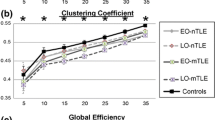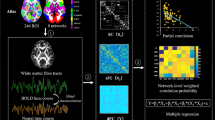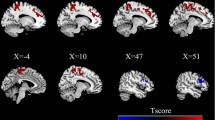Abstract
Frontal lobe epilepsy has recently been associated with disrupted brain functional connectivity; variations among various resting-state networks (RSNs) across time remains largely unclear. This study applied dynamic functional network connectivity (dFNC) analysis to investigate functional patterns in the temporal and spatial domains of various functional systems in FLE. Resting-state fMRI data were acquired from 19 FLE patients and 18 controls. Independent component analysis was used to decompose RSNs, which were grouped into seven functional systems. Sliding windows and clustering approach were used to identify the dFNC patterns. Then, state-specific connectivity pattern and dynamic functional state interactions (dFSIs) were evaluated. Compared with healthy controls, FLE patients exhibited decreased dFNC in almost all four patterns, changes that were mostly related to the frontoparietal system, suggesting a disturbed communication of the frontoparietal system with other systems in FLE. Additionally, regarding the fundamental connectivity pattern (state 3 in this study), FLE showed decreased time spent in this state. Moreover, the duration positively correlated with seizure onset. Furthermore, significantly reduced dynamic connections in this state were observed in the frontoparietal system linked to the cerebellar and subcortical systems. These findings imply abnormal fundamental dynamic interactions and dysconnectivity associated with the subcortical and cerebellar regulation of dysfunctions in frontoparietal regions in FLE. Finally, based on the developed FSI analysis, temporal dynamic abnormalities among states were observed in FLE. Therefore, this altered dynamic FNC extended our understanding of the abnormalities in the frontoparietal system in FLE. The dynamic FNC provided novel insight into the fundamental pathophysiological mechanisms in FLE.




Similar content being viewed by others
References
Allen EA, Damaraju E, Plis SM, Erhardt EB, Eichele T, Calhoun VD (2011) Tracking whole-brain connectivity dynamics in the resting state. Cereb Cortex 24:663–676
An D, Dubeau F, Gotman J (2015) BOLD responses related to focal spikes and widespread bilateral synchronous discharges generated in the frontal lobe. Epilepsia 56(3):366–374
Beckmann CF, Mackay CE, Filippini N, Smith SM (2009) Group comparison of resting-state FMRI data using multi-subject ICA and dual regression. NeuroImage 47:S39–S41. https://doi.org/10.1016/S1053-8119(09)71511-3
Beleza P, Pinho J (2011) Frontal lobe epilepsy. J Clin Neurosci 18(5):593–600
Braakman H, Vaessen M, Hofman P, Debeij-van Hall M, Backes W, Vles J, Aldenkamp A (2011) Cognitive and behavioral complications of frontal lobe epilepsy in children: a review of the literature. Epilepsia 52:849–856
Braakman H, Vaessen M, Jansen J, Debeij-van Hall M, de Louw A, Hofman P et al (2013) Frontal lobe connectivity and cognitive impairment in pediatric frontal lobe epilepsy. Epilepsia 54:446–454
Chang C, Glover G (2010) Time frequency dynamics of resting state brain connectivity measured with fMRI. Neuroimage 50:81–98. https://doi.org/10.1016/j.neuroimage.2009.12.001
Damaraju E, Allen E, Belger A, Ford J, McEwen S, Mathalon D et al (2014) Dynamic functional connectivity analysis reveals transient states of dysconnectivity in schizophrenia. NeuroImage:Clinical 5:298–308
Deco G, Ponce-Alvarez A, Mantini D, Romani G, Hagmann P, Corbetta M (2013) Resting-state functional connectivity emerges from structural and dynamically shaped slow linear fluctuation. J Neurosci 33:11239–11252
Direito B, Teixeira CA, Sales F, Castelo-Branco M, Dourado A (2017) A realistic seizure prediction study based on multiclass SVM. Int J Neural Syst 27(3):1750006. https://doi.org/10.1142/S012906571750006X
Doelken M, Mennecke A, Huppertz H (2012) Multimodality approach in cryptogenic epilepsy with focus on morphometric 3T MRI. J Neuroradiol 39(2):87–96
Dong L, Wang P, Peng R, Jiang S, Klugah-Brown B, Luo C, Yao D (2016) Altered basal ganglia-cortical functional connections in frontal lobe epilepsy: a resting-state fMRI study. Epilepsy Res 128:12–20
Dong L, Luo C, Liu X, Jiang S, Feng H, Li J, Gong D, Yao D (2018) Neuroscience information toolbox: an open source toolbox for EEG-fMRI multimodal fusion analysis. Front Neuroinform 12:56
Engel J Jr, International League Against Epilepsy (ILAE) (2001) A proposed diagnostic scheme for people with epileptic seizures and with epilepsy: report of the ILAE Task Force on Classification and Terminology. Epilepsia 42(6):796–803
Exner C, Boucsein K, Lange C, Winter H, Weniger G, Steinhoff B, Irle E (2002) Neuropsychological performance in frontal lobe epilepsy. Seizure 11:20–32
Fletcher P, Henson R (2001) Henson, frontal lobes and human memory. Brain 124:849–881
Geier C, Lehnertz K (2017) Which brain regions are important for seizure dynamics in epileptic networks? Influence of link identification and EEG recording montage on node centralities. Int J Neural Syst 27(1):1550035. https://doi.org/10.1142/S0129065715500355
Graña M, Ozaeta L, Chyzhyk D (2017) Resting state effective connectivity allows auditory hallucination discrimination. Int J Neural Syst 27(05):1750019. https://doi.org/10.1142/S0129065717500198
Jafri M, GD P, Stevens M, Calhoun V (2008) A method for functional network connectivity among spatially independent resting-state components in schizophrenia. Neuroimage 39:1666–1681
Jiang S, Luo C, Gong J, Peng R, Ma S, Tan S et al (2017) Aberrant thalamocortical connectivity in juvenile myoclonic epilepsy. Int J Neural Syst. https://doi.org/10.1142/S0129065717500344
Jiang Y, Luo C, Li X, Li Y, Yang H, Li J, Chang X, Li H, Yang H, Wang J, Duan M, Yao D (2018) White-matter functional networks changes in patients with schizophrenia. Neuroimage. https://doi.org/10.1016/j.neuroimage.2018.1004.1018
Kellinghaus C, Lüders HO (2004) Frontal lobe epilepsy. Epileptic Disord 6(4):223–239
Kros L, Eelkman RO, De Zeeuw C, Hoebeek F (2015a) Controlling cerebellar output to treat refractory epilepsy. Trends Neurosci 38(12):787–799. https://doi.org/10.1016/j.tins.2015.10.002
Kros L, Eelkman ROH, Spanke JK, Alva P, van Dongen MN, Karapatis A et al (2015b) Cerebellar output controls generalized spike-and-wave discharge occurrence. Ann Neurol. https://doi.org/10.1002/ana.24399
Li Q, Cao W, Liao X, Chen Z, Yang T, Gong Q et al (2015) Altered resting state functional network connectivity in children absence epilepsy. J Neurol Sci 354(1–2):79–85
Li J, Zhou W, Yuan S, Zhang Y, Li C, Wu Q (2016) An Improved sparse representation over learned dictionary method for seizure detection. Int J Neural Syst 26(1):1750006. https://doi.org/10.1142/S012906571750006X
Li Q, Chen Y, Wei Y, Chen S, Ma L, He Z, Chen Z (2017a) Functional network connectivity patterns between idiopathic generalized epilepsy with myoclonic and absence seizures. Front Comput Neurosci. https://doi.org/10.3389/fncom.2017.00038. (ecollection)
Li R, Ji GJ, Yu Y, Yu Y, Ding MP, Tang YL, Chen H, Liao W (2017b) Epileptic discharge related functional connectivity within and between networks in benign epilepsy with centrotemporal spikes. Int J Neural Syst 27(7):1750018. https://doi.org/10.1142/S0129065717500186
Luo C, Qiu C, Guo Z, Fang J, Li Q, Lei X et al (2012) Disrupted functional brain connectivity in partial epilepsy: a resting-state fMRI study. PLoS ONE 7:e28196
Luo C, An D, Yao D, Gotman J (2014) Patient-specific connectivity pattern of epileptic network in frontal lobe epilepsy. Neuroimage Clin 4:668–675
Luo C, Zhang Y, Cao W, Huang Y, Yang F, Wang J et al (2015) Altered structural and functional feature of striato-cortical circuit in benign epilepsy with centrotemporal spikes. Int J Neural Syst 25(6): 1550027
Mayo Clinic (2008) Mayoclinic. http://Mayoclinic.com. Accessed Sept 2017
McAvoy M, Larson-Prior L, Nolan T, Vaishnavi S, Raichle M, d’Avossa G (2008) Resting states affect spontaneous BOLD oscillation in sensory and paralimbic cortex. J Neurophysiol 100:922–931
Norden A, Blumenfeld H (2002) The role of subcortical structures in human epilepsy. Epilepsy Behav 3:219–231
Power JD, Barnes KA, Snyder AZ, Schlaggar BL, Petersen SE (2012) Spurious but systematic correlations in functional connectivity MRI networks arise from subject motion. Neuroimage 59:2142–2154
Rashid B, Damaraju E, Pearlson GD, Calhoun VD (2014) Dynamic connectivity states estimated from resting fMRI Identify differences among Schizophrenia, bipolar disorder, and healthy control subjects. Front Hum Neurosci 8:897. https://doi.org/10.3389/fnhum.2014.00897. (eCollection 2014)
Shen K, Hutchison R, Bezgin G, Everling S, McIntosh A (2015) Network structure shapes spontaneous functional connectivity dynamics. J Neurosci 35:5579–5588
Tan Y, Tan J, Deng J, Cui W, He H, Yang F et al (2015) Alteration of basal ganglia and right frontoparietal network in early drug-naive Parkinson’s disease during heat pain stimuli and resting state. Front Hum Neurosci 9:467
Tracy J, Doucet G (2015) Resting-state functional connectivity in epilepsy: growing relevance for clinical decision making. Curr Opin Neurol 28(2):158–165
Wang L, Liu Q, Shen H, Li H, Hu D (2015) Large-scale functional brain network changes in taxi drivers: evidence from resting state fMRI. Hum Brain Mapp 36:862–871
Williamson P, Jobst B (2000) Frontal lobe epilepsy. In: Williamson P, Siegel A, Roberts D, Thadani V, Gazzaniga M, (eds) Advances in neurology. Raven Press, Philadelphia pp 215–251
Xiaobo C, Han Z, Yue G, Chong-Yaw W, Gang L, Dinggang S, the Alzheimer’s Disease Neuroimaging Initiative (2016) High-order resting-state functional connectivity network for MCI classification. Hum Brain Mapp 37: 3282–3296
Zhang H, Chen X, Zhang Y, Shen D (2017) Test-Retest Reliability of “high-order” functional connectivity in young healthy adults. Front Neurosci 11:439. https://doi.org/10.3389/fnins.2017.00439
Zhong C, Liu R, Luo C, Jiang S, Dong L, Peng R, Guo F, Wang P (2018) Altered structural and functional connectivity of juvenile myoclonic epilepsy: an fMRI study. Neural Plast. https://doi.org/10.1155/2018/7392187
Acknowledgements
This work was supported by grants from the National Nature Science Foundation of China (Grant Nos. 81771822, 81471638 and 81330032); The Project of Science and Technology Department of Sichuan Province (Nos. 2017SZ0004 and 2017HH0001); and the ‘111’ project of China (Grant No. B12027). We thank Dr. Jiang and Dr. Wang for their help in collecting data.
Author information
Authors and Affiliations
Corresponding author
Ethics declarations
Conflict of interest
None of the authors had any conflicts of interest to disclose. We confirm that we have read the Journal’s position on the issues involved in ethical publication and affirm that this report is consistent with those guidelines.
Additional information
Handling Editor: Louis Lemieux.
Electronic supplementary material
Below is the link to the electronic supplementary material.
Rights and permissions
About this article
Cite this article
Klugah-Brown, B., Luo, C., He, H. et al. Altered Dynamic Functional Network Connectivity in Frontal Lobe Epilepsy. Brain Topogr 32, 394–404 (2019). https://doi.org/10.1007/s10548-018-0678-z
Received:
Accepted:
Published:
Issue Date:
DOI: https://doi.org/10.1007/s10548-018-0678-z




